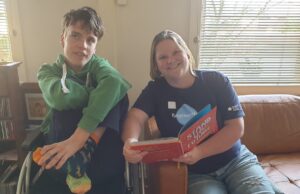Introducing Associate Professor Kate Fox
The Alliance is unusual – we are bringing together academic engineers and commercial partners from the very beginning of our audacious program. We hope shared knowledge and a diverse approach will fast-track the development of CT devices that are light and affordable – for use all over the world.

Kate reads with her son, Jake, as part of the Chief Scientist’s Reading Challenge
Associate Professor Kate Fox, @Engineeringkate, is an integral member of the Alliance team, working from RMIT’s School of Engineering. Along with colleague Professor Cees Bil, Kate is helping us integrate the CT device into helicopters, fixed wing planes and road ambulances.
Kate, you’re shrinking a massive brain scanner! Where do you begin?
A conventional CT machine in a hospital weighs around 500kg, so we’ve been taking it apart and stripping out components not needed for it to function. The whole reason we all become engineers is to be able to have fun, pulling things apart to make items better and stronger. As a kid, I remember taking apart the Nintendo to make the games load better. The Nintendo never quite worked the same after that but I assure you I am much more qualified now!
In this project, we’ve then been redesigning the scanner to make it simpler, making it hollow or thinner, and building in a lattice for strength. We’re rebuilding a much lighter machine using additive manufacturing techniques and clever design to create lighter components.
What else do you need to consider?
Well, the aircraft will be carrying more than the scanner. The Royal Flying Doctor Service and the various ambulance services around the country will be taking the hospital to the patient. It’s such a brilliant idea and is so logical when you think about the need to treat a stroke patient as quickly as possible. Onboard will be paramedics, pilots, a radiographer and a medico. They all add to the weight being transported, along with loads of other medical equipment needed for critical care in remote locations. Oh, and there will be a patient onboard, too!
From a techy perspective, what sort of challenges are you facing?
Fitting heavy and delicate medical equipment on an aircraft is a significant engineering challenge. It’s not designed to fly and will be subjected to vibration, temperature variations and g-loads. Further as we move the technologies to more remote communities the CT scanner will be subject to temperatures and dust rarely seen with current devices. We also need to make sure that there is room for the paramedics and doctors to access the patient from all sides.
The images produced by the machine must be high quality so the correct treatment can be given to the stroke patient. We are very fortunate to have some amazing industry partners to aid us in this project. Five Rings Aerospace is working closely with us to be able to fit out the aircraft with our equipment. They are a great local company with amazing experience in aircraft design, certification and manufacturing and will be integral in getting our re-designed scanner into the air. Further, the Siemens Healthineers have such a large volume of learned knowledge regarding CT scanner technologies and we are so lucky to be working with them on this project.
We know you are deeply committed to this project.
The best part of working on this project and with the team we have is the collective capacity to make a real difference to the lives of many. As a biomedical engineer, we choose this path as it provides an opportunity to affect so many people by developing technologies that literally save lives. I always like to say our role as an engineer is to invent solutions for problems that are yet to exist. If you look at something like stroke detection technology, we all think of the large cumbersome CT scanners sitting in the basement of a hospital. Until now, there hasn’t been a reason to consider its weight and size. Now we are faced with the challenge to make it portable and light enough for a fixed wing aircraft or a helicopter to hold! This is where engineering aligns with a detective novel: What components do we actually need for a small CT scanner to be able to take images capable of detecting a stroke?
I am so motivated to take stroke detection, via the air, to remote communities. When I was pregnant with my son, he suffered a stroke towards the end of the pregnancy. We were so fortunate to be located in a major Australian city and the stroke could be detected and treated soon after diagnosis. All I can think of now is: What would have happened if we had been located in a country or remote community?
This project provides the opportunity to make healthcare more equitable around Australia and that is something I think is just so fantastic.
A crazy fact to share?
As an engineer I also work on using 3D printing to print materials like diamond to make implants. Did you know that when you light a birthday candle, the sparkles of light that appear to bounce off the candle are actually millions of tiny burning diamonds in the air!
Kate has been named as one of Engineers Australia’s Top 30 most innovative engineers, is the recipient of a Victorian Tall Poppy Award and is recognised by Science and Technology Australia as a current Superstar of STEM.
We are very fortunate to include her on our team.
Interested to read more? Please visit: